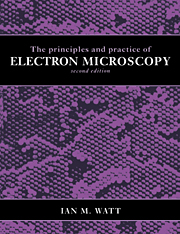Book contents
- Frontmatter
- Contents
- Preface to first edition
- Preface to second edition
- 1 Microscopy with light and electrons
- 2 Electron–specimen interactions: processes and detectors
- 3 The electron microscope family
- 4 Specimen preparation for electron microscopy
- 5 The interpretation and analysis of micrographs, pages 189 to 223
- The interpretation and analysis of micrographs, pages 224 to 262
- 6 Analysis in the electron microscope
- 7 Specialised EM- and other microscopical and analytical techniques
- 8 Examples of the use of electron microscopy
- Appendixes
- Bibliography
- Name index
- Subject index
5 - The interpretation and analysis of micrographs, pages 189 to 223
Published online by Cambridge University Press: 05 June 2012
- Frontmatter
- Contents
- Preface to first edition
- Preface to second edition
- 1 Microscopy with light and electrons
- 2 Electron–specimen interactions: processes and detectors
- 3 The electron microscope family
- 4 Specimen preparation for electron microscopy
- 5 The interpretation and analysis of micrographs, pages 189 to 223
- The interpretation and analysis of micrographs, pages 224 to 262
- 6 Analysis in the electron microscope
- 7 Specialised EM- and other microscopical and analytical techniques
- 8 Examples of the use of electron microscopy
- Appendixes
- Bibliography
- Name index
- Subject index
Summary
Interpretation of transmission micrographs
The specimen has been prepared and put into the microscope. The beam is turned on and the image focused on the fluorescent screen. How should we now interpret the light and shadow in relation to the original specimen which was provided?
With most types of specimen working out the meaning of a TEM image is straightforward once a few basic principles have been appreciated. The image we are considering is the electron image on the fluorescent screen, or the finished photographic or video print which can be examined more conveniently than the screen image. The silver image on the processed photographic film, which is strictly speaking the true micrograph, will be reversed in tone from the other two, bright areas on the screen giving dark areas on the film and vice versa.
In the absence of a specimen the image field would be uniformly bright. It is darkened when the specimen is inserted because electrons have been scattered out of the illuminating beam by passage close to the atoms in the specimen (Figure 5.1). Detail in the electron image results from localised variations in the scattering power of the specimen. More electrons may be scattered, i.e. the image will be darker, if the specimen is thicker or composed of heavier atoms, or both. An important distinction between light- and electron microscopy lies in the fact that image contrast in the former is caused by differential absorption of illumination whereas in the latter the operative mechanism is scattering without absorption.
- Type
- Chapter
- Information
- The Principles and Practice of Electron Microscopy , pp. 189 - 223Publisher: Cambridge University PressPrint publication year: 1997

